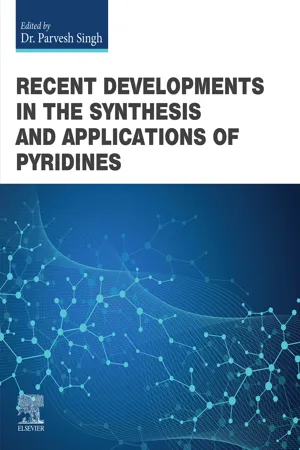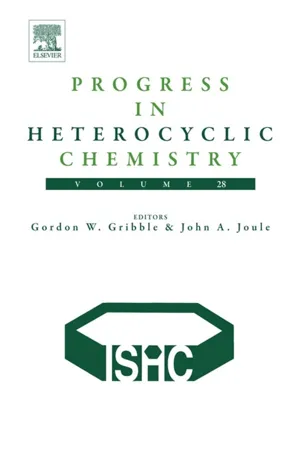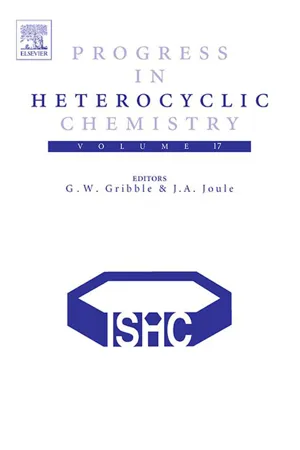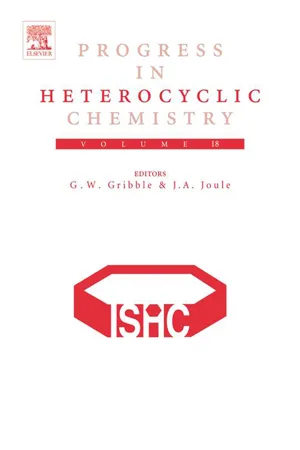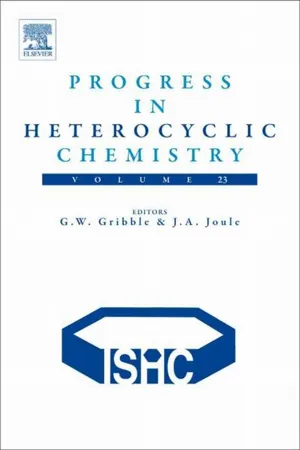Chemistry
Pyrrole
Pyrrole is a heterocyclic aromatic organic compound that contains a five-membered ring with four carbon atoms and one nitrogen atom. It is a component of many natural products, such as chlorophyll, and is used in the synthesis of pharmaceuticals, dyes, and polymers. Pyrrole derivatives also have biological activities, including anti-inflammatory and antitumor properties.
Written by Perlego with AI-assistance
5 Key excerpts on "Pyrrole"
- Parvesh Singh(Author)
- 2022(Publication Date)
- Elsevier(Publisher)
Its cyclic nature was recognized by Dewar and Korner in 1869 [8]. Pyridine and its related derivatives are a privileged class of heterocyclic compounds found in various chemotherapeutic agents [ 9, 10 ]. Pyridine is widely found in many natural products such as vitamins, alkaloids and coenzymes and forms the nucleus of around 253 FDA-approved drugs. Pyridine-based compounds are known to possess a remarkable biological and pharmacological activity including antimicrobial [11], antimalarial [12], anticancer [13], HIV inhibitors [14], antioxidant [15], and many others [16]. Pyridine moieties are frequently used in drugs due to their characteristics such as stability, water solubility, basicity, hydrogen bond-forming capacity, and small molecular size, which help to improve pharmacokinetic, pharmacological, and physicochemical properties. The effective therapeutic behavior of pyridines in drug discovery is mainly based on their mimicking nature. Pyridine ring acts as bioisostere of benzene, amines, amides, and other nitrogen-containing heterocycles. Pyridine is aromatic and possesses six delocalized electrons in the ring (Fig. 12.1). The nitrogen's lone electron pair of pyridine occupies sp 2 orbital parallel to the ring plane. Therefore, this electron pair does not participate in the aromatic π-system ring and more available for donation. In comparison to benzene, pyridine is an electron deficient and polar molecule due to the electron-withdrawing effect of the highly electronegative nitrogen atom. The electron density in pyridine ring at the C-2, C-4, and C-6 positions is less than that at the C-3 and C-5 positions. Therefore, pyridine has a dipole moment and a weaker resonant stabilization than benzene- eBook - ePub
- Gordon Gribble, John A. Joule(Authors)
- 2016(Publication Date)
- Elsevier(Publisher)
H functionalization. Although the total synthesis of natural products is not a focus of this monograph, certain key steps may be covered. Review articles published in 2015 will be noted in the appropriate sections.Passage contains an image
5.2.2. Synthesis of Pyrroles
Advances in the synthesis and application of natural and artificial bioactive Pyrrole derivatives were reviewed (15EJMC176 ). The role of Pyrrole as a small molecule in medicinal compounds was covered by Bhardwaj (15RSCA15233 ). Titanium-catalyzed multicomponent couplings as efficient one-pot syntheses of Pyrroles and nitrogen heterocycles were reviewed (15ACR2822 ).5.2.2.1. Intramolecular Approaches to Pyrroles
5.2.2.1.1. Intramolecular Type a
Gevorgyan and coworkers demonstrated that imine 1 , upon treatment with a gold catalyst, underwent a migratory cycloisomerization process to furnish Pyrrole 2 . If silylated imines were instead used as substrates for the reaction, a double migratory process occurred leading to 2,3,4-substituted Pyrroles (such as 3 ). Notably, if aldehydes were used in place of the imines, substituted furans were obtained in excellent yields (15TL3251 ).Tetrasubstituted Pyrrole 5 was prepared by the treatment of 1,3-enyne 4 with aniline under copper catalysis. The sequence is tolerant of a variety of electron-donating or electron-withdrawing groups on the aniline; if phenylhydrazine was instead used as the nitrogen source, pyrazole 6 was obtained in 93% yield (15OBC2786 ).Jiang and colleagues reported a novel, palladium-catalyzed approach to N -aryl Pyrrole 9 . The reaction is proposed to proceed first by an intermolecular Heck reaction with boronic acid 8 and the pendant alkene on 7 . The intermediate then undergoes an intramolecular aza-Wacker cyclization to give the final product. An advantage of this approach is the ready accessibility of both of the aniline and boronic acid starting materials as well as the good yields of the polysubstituted Pyrrole products (15JOC1235 ).5.2.2.1.2. Intramolecular Type c
Wan reported the base-selective synthesis of Pyrrole 11 and bicycle 12 from a common scaffold, enyne 10 . If R=OPh, the reaction is suggested to proceed through an intermediate allene, which cyclizes onto the enamine to provide vinyl Pyrrole 11 in moderate to good yields. If, however, R is an aryl or alkyl group, the intermediate allene is proposed to undergo a [2 + 2]-cycloaddition with the alkene, followed by a formal 1,3-hydrogen shift and 1,3-sulfonyl migration leading to heterocycle 12 (which was supported by a series of deuterium labeling studies) (15OL3944 - eBook - ePub
- Gordon Gribble, J. Joule(Authors)
- 2005(Publication Date)
- Elsevier Science(Publisher)
Chapter 5.2Five-membered ring systems: Pyrroles and benzo derivatives
Erin T. Pelkey [email protected] Hobart and William Smith Colleges, Geneva, NY 144565.2.1 INTRODUCTION
The synthesis and chemistry of Pyrroles, indoles, and additional fused Pyrrole ring systems reported during the past year (Jan-Dec 2004) are the subjects of this review. Pyrroles and indoles are amongst the most studied and reported heterocyclic ring systems due to their diverse biological activity and materials science applications. Page restrictions limit this review to selected advances. A number of specialized reviews covering aspects of Pyrrole and structurally related fused heterocycles have appeared. The synthesis of texaphyrin conjugates <04PAC365 >, Pyrrole macrocycles <04AG(E)1918 >, marine alkaloid natural products (variolins <04M615 > and lamellarins <04M615 , 04PHC1 >), benzo[b ]furoindoles <04CHE967 >, and furocarbazoles <04H(63)2393 > have been published. The synthesis and isolation of indole alkaloid natural products containing a non-rearranged monoterpenoid unit from the 2002 literature has been reviewed <04NPR278 >. The preparation of Pyrroles utilizing multicomponent coupling reactions has been highlighted <04AG(E)6238 >. The synthesis and reactions of Pyrrole oximes has been reviewed <04CHE1 >. The utility of C -vinylpyrroIes as building blocks has been elaborated <04CR2481 >. Part of a review detailed the use of the microwave irradiation in heterocylic synthesis includes Pyrrole, indoles, and isatins <04H(63)903 >. Finally, the biological activity of side-chain fluorinated indoles has been reviewed <04JFC501 >.5.2.2 SYNTHESIS OF PyrroleS
During the past few years, the polyoxygenated 2,3,4-triarylPyrrole natural products known collectively as the lamellarins have been amongst the most thoroughly studied class of natural products. An interesting cyclocondensation reaction between imine 1 and nitroalkene ester 2 led to highly functionalized Pyrrole ester 3 , an intermediate which was converted to lamellarin L <04AG(E)866 - eBook - ePub
- Gordon Gribble, J. Joule(Authors)
- 2011(Publication Date)
- Elsevier Science(Publisher)
Chapter 5.2Five-membered ring systems: Pyrroles and benzo analogs
Erin T. Pelkey [email protected] Hobart and William Smith Colleges, Geneva, NY 144565.2.1 INTRODUCTION
Pyrroles and indoles are likely the most studied and reported of all heterocyclic ring systems and there was a noticeable increase in citations this year compared to previous years.Pyrrole chemistry investigated by the Banwell (Pyrrole alkaloids) <05COC1589 > and Jacobi (phytochrome) <05SL2861 > research groups has been reviewed. A number of indole review articles have been published that are based on the work of a number of leading research groups including: Borschberg (Aristotelia alkaloids) <05COC1465 >, Gribble (electron-deficient and [b ]-fused indoles) <05COC1493 >, Knölker (carbazole alkaloids) <05COC1601 >, Takayama (Corynanthe alkaloids) <05COC1445 >, and Umani-Ronchi (stereoselective alkylation reactions) <05SL1199 >. A monograph detailing the preparation and reactions of 5,6-dihydroxyindoles and indole-5,6-diones was published <05AHC1 >. A comprehensive review of the synthesis and elaboration of indoles utilizing palladium catalysts has appeared <05CR2873 >. Additional review articles will be mentioned later in the text.5.2.2 SYNTHESIS OF PyrroleS
In order improve the organization of this section, Pyrrole syntheses have been categorized utilizing the systematic approach utilized by Sundberg <96CHEC-II119 >. Intramolecular approaches (type I) and intermolecular approaches (type II) are classified by the number and location of the new bonds that describe the Pyrrole ring forming step as shown opposite.5.2.2.1 Intramolecular Approaches
A few metal-mediated type Ia cyclizations have been reported. A gold(I)-catalyzed addition of an azide to a proximal alkyne was utilized to prepare 2,5-disubstituted Pyrroles and higher functionalized Pyrroles <05JA11260 >. For example, treatment of azido alkyne 1 with a gold(I) catalyst led to the formation of Pyrrole 2 presumably via gold(I) activation of the alkyne. In a related sequence utilized to prepare N -bridgehead Pyrroles 3 , silver nitrate was utilized to induce the addition of vinylogous carbamates onto pendant alkynes <05EJO505 - eBook - ePub
- Gordon Gribble, John A. Joule(Authors)
- 2011(Publication Date)
- Elsevier(Publisher)
Chapter 5.2 Five-Membered Ring SystemsPyrroles and Benzo AnalogsJonathon S. Russel* , Erin T. Pelkey** , Jessica G. Greger*** St. Norbert College, De Pere, WI 54115, USA** Hobart and William Smith Colleges, Geneva, NY 14456, USA[email protected] [email protected]5.2.1. Introduction
The synthesis and chemistry of Pyrroles, indoles, and other fused ring systems reported during 2010 are reviewed in this monograph. Indoles and Pyrroles continue to draw a lot of attention from the scientific community due to their prevalence in natural products and their wide range of biological and materials science applications. Indoles (by J. S. R.) and Pyrroles (by E. T. P. and J. G. G.) are treated in separate sections. Coverage of indole and Pyrrole natural product total synthesis is directly incorporated into advances in ring synthesis or ring substitution. Review articles and monographs from 2010 will be mentioned in the relevant sections.5.2.2. Synthesis of Pyrroles
As has been past practice for the past several years, de novo Pyrrole syntheses have been organized systematically into intramolecular and intermolecular approaches as well as by the location of the new bonds that describe the Pyrrole ring forming step (two examples illustrated below). Multicomponent reactions leading to Pyrroles and Pyrrole syntheses accomplished by transformation of other heterocycles appear at the end of this section. Thompson and coworkers wrote two reviews focused on the synthesis of chiral Pyrroles 〈10CC1797 〉 and the synthesis of Pyrrole natural products 〈10NPR1801 〉.5.2.2.1 Intramolecular Approaches to Pyrroles
5.2.2.1.1 Intramolecular Type a
Increasingly ubiquitous are type “a” approaches to Pyrroles that involve base or metal-mediated 5-endo cyclizations of unsaturated amine systems. The synthetic power of these approaches has been further demonstrated in the synthesis of a variety of complex, fused Pyrroles including pyrrolocoumarin 1 〈10S4207 〉, thieno[2,3-b ]Pyrrole 2 〈10T1800 〉, pyrrolo[3,2-d ]pyrimidine 3 〈10T1800 〉, and pyrrolo[2,3-d ]thiazole 4 〈10S3152 〉. The Söderberg group prepared several fused Pyrroles (including 2 and 3 ) by reductive 5-endo cyclizations of the corresponding o
Index pages curate the most relevant extracts from our library of academic textbooks. They’ve been created using an in-house natural language model (NLM), each adding context and meaning to key research topics.
Explore more topic indexes
Explore more topic indexes
1 of 6
Explore more topic indexes
1 of 4
